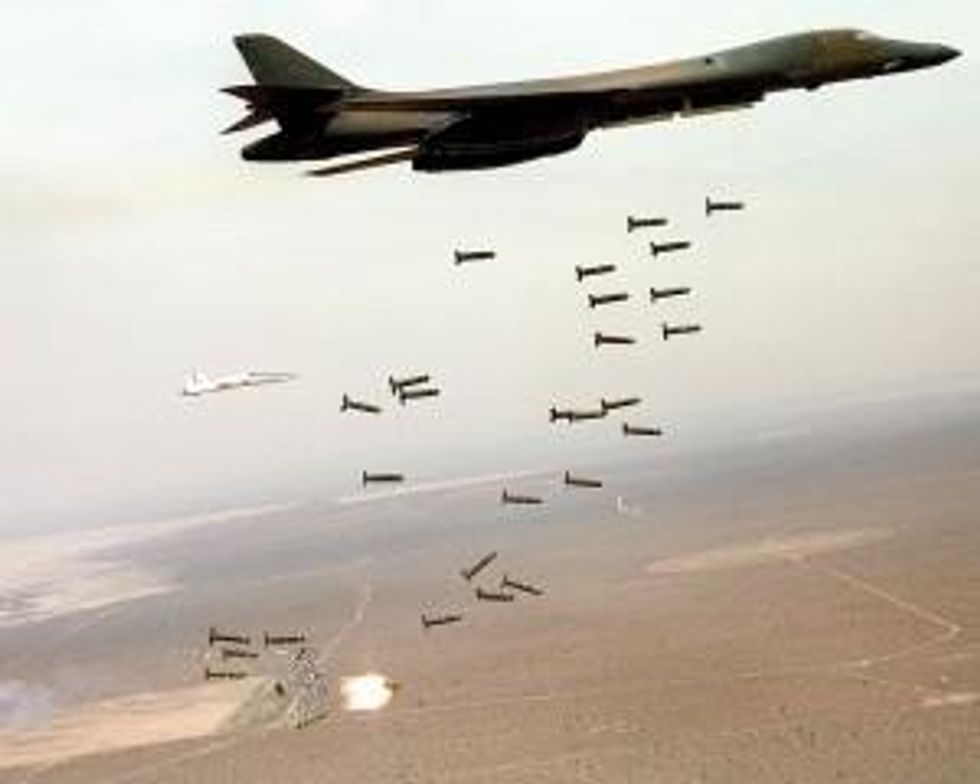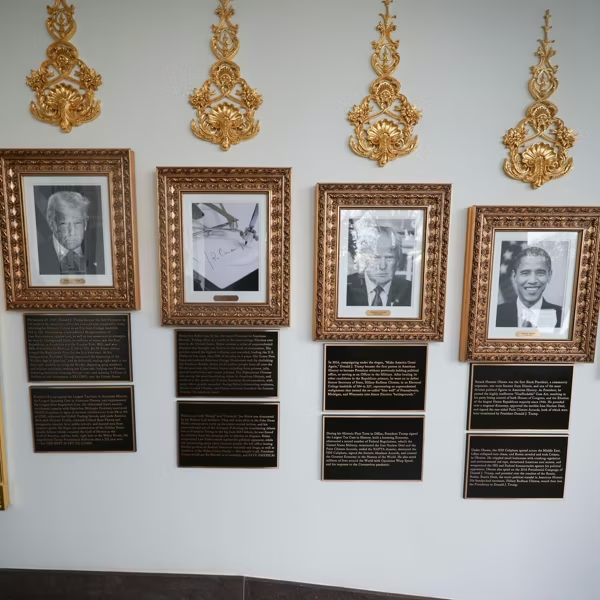The New York Times has an article today (9/5/13) about a Human Rights Watch report charging Syria's government with the use of cluster bombs, a "widely prohibited weapon." Cluster bombs are munitions that release hundreds of miniature explosives; as the Times' Rick Gladstone writes, "Each bomblet detonates on impact, spraying shrapnel in all directions and killing, maiming and destroying indiscriminately."

Gladstone quotes a Human Rights Watch spokesperson calling cluster bombs "insidious weapons that remain on the ground, causing death and destruction for decades." The reporter goes on to cite the Cluster Munitions Coalition peace group on the deadly effects of these weapons:
The coalition said that children make up one-third of all casualties caused by cluster munitions. It said 60 percent of the total casualties caused by the weapons are civilians going about normal activities.
There's a Convention on Cluster Munitions signed by 112 countries who have agreed not to use or possess these weapons. Who wouldn't agree to such a thing? Well, aside from Syria, the article does mention:
There are 85 countries that have not signed the convention, including three permanent members of the Security Council-China, Russia and the United States. Most countries in the Middle East have not signed, including Syria, Israel and Jordan.
Huh-so the country that the New York Times is based in, where most of its readers live, is one of the countries that refuses to sign the treaty banning these horrific weapons? Maybe that's worth a mention before the eighth of 11 paragraphs.
In fact, readers might be interested to know that not only does the U.S. not ban cluster bombs, it actually uses them-they've been used by US forces in Serbia, Afghanistan and Iraq, with the most recent target being Yemen. As the Human Rights Watch report notes in a portion not quoted by the Times:
The last reported US use of a cluster munition was in Yemen on December 17, 2009, when one or more TLAM-D cruise missiles loaded with BLU-97 bomblets struck the hamlet of al-Majala in southern Abyan province, causing more than 40 civilian casualties.
But that's the strange thing about cluster bombs: When they're used by official enemies, they're weapons of indiscriminate terror (FAIR Blog, 4/16/11, 1/2/13). When they're used by the United States, they're not much worth talking about.
An Urgent Message From Our Co-Founder
Dear Common Dreams reader, The U.S. is on a fast track to authoritarianism like nothing I've ever seen. Meanwhile, corporate news outlets are utterly capitulating to Trump, twisting their coverage to avoid drawing his ire while lining up to stuff cash in his pockets. That's why I believe that Common Dreams is doing the best and most consequential reporting that we've ever done. Our small but mighty team is a progressive reporting powerhouse, covering the news every day that the corporate media never will. Our mission has always been simple: To inform. To inspire. And to ignite change for the common good. Now here's the key piece that I want all our readers to understand: None of this would be possible without your financial support. That's not just some fundraising cliche. It's the absolute and literal truth. We don't accept corporate advertising and never will. We don't have a paywall because we don't think people should be blocked from critical news based on their ability to pay. Everything we do is funded by the donations of readers like you. Will you donate now to help power the nonprofit, independent reporting of Common Dreams? Thank you for being a vital member of our community. Together, we can keep independent journalism alive when it’s needed most. - Craig Brown, Co-founder |
The New York Times has an article today (9/5/13) about a Human Rights Watch report charging Syria's government with the use of cluster bombs, a "widely prohibited weapon." Cluster bombs are munitions that release hundreds of miniature explosives; as the Times' Rick Gladstone writes, "Each bomblet detonates on impact, spraying shrapnel in all directions and killing, maiming and destroying indiscriminately."

Gladstone quotes a Human Rights Watch spokesperson calling cluster bombs "insidious weapons that remain on the ground, causing death and destruction for decades." The reporter goes on to cite the Cluster Munitions Coalition peace group on the deadly effects of these weapons:
The coalition said that children make up one-third of all casualties caused by cluster munitions. It said 60 percent of the total casualties caused by the weapons are civilians going about normal activities.
There's a Convention on Cluster Munitions signed by 112 countries who have agreed not to use or possess these weapons. Who wouldn't agree to such a thing? Well, aside from Syria, the article does mention:
There are 85 countries that have not signed the convention, including three permanent members of the Security Council-China, Russia and the United States. Most countries in the Middle East have not signed, including Syria, Israel and Jordan.
Huh-so the country that the New York Times is based in, where most of its readers live, is one of the countries that refuses to sign the treaty banning these horrific weapons? Maybe that's worth a mention before the eighth of 11 paragraphs.
In fact, readers might be interested to know that not only does the U.S. not ban cluster bombs, it actually uses them-they've been used by US forces in Serbia, Afghanistan and Iraq, with the most recent target being Yemen. As the Human Rights Watch report notes in a portion not quoted by the Times:
The last reported US use of a cluster munition was in Yemen on December 17, 2009, when one or more TLAM-D cruise missiles loaded with BLU-97 bomblets struck the hamlet of al-Majala in southern Abyan province, causing more than 40 civilian casualties.
But that's the strange thing about cluster bombs: When they're used by official enemies, they're weapons of indiscriminate terror (FAIR Blog, 4/16/11, 1/2/13). When they're used by the United States, they're not much worth talking about.
The New York Times has an article today (9/5/13) about a Human Rights Watch report charging Syria's government with the use of cluster bombs, a "widely prohibited weapon." Cluster bombs are munitions that release hundreds of miniature explosives; as the Times' Rick Gladstone writes, "Each bomblet detonates on impact, spraying shrapnel in all directions and killing, maiming and destroying indiscriminately."

Gladstone quotes a Human Rights Watch spokesperson calling cluster bombs "insidious weapons that remain on the ground, causing death and destruction for decades." The reporter goes on to cite the Cluster Munitions Coalition peace group on the deadly effects of these weapons:
The coalition said that children make up one-third of all casualties caused by cluster munitions. It said 60 percent of the total casualties caused by the weapons are civilians going about normal activities.
There's a Convention on Cluster Munitions signed by 112 countries who have agreed not to use or possess these weapons. Who wouldn't agree to such a thing? Well, aside from Syria, the article does mention:
There are 85 countries that have not signed the convention, including three permanent members of the Security Council-China, Russia and the United States. Most countries in the Middle East have not signed, including Syria, Israel and Jordan.
Huh-so the country that the New York Times is based in, where most of its readers live, is one of the countries that refuses to sign the treaty banning these horrific weapons? Maybe that's worth a mention before the eighth of 11 paragraphs.
In fact, readers might be interested to know that not only does the U.S. not ban cluster bombs, it actually uses them-they've been used by US forces in Serbia, Afghanistan and Iraq, with the most recent target being Yemen. As the Human Rights Watch report notes in a portion not quoted by the Times:
The last reported US use of a cluster munition was in Yemen on December 17, 2009, when one or more TLAM-D cruise missiles loaded with BLU-97 bomblets struck the hamlet of al-Majala in southern Abyan province, causing more than 40 civilian casualties.
But that's the strange thing about cluster bombs: When they're used by official enemies, they're weapons of indiscriminate terror (FAIR Blog, 4/16/11, 1/2/13). When they're used by the United States, they're not much worth talking about.

